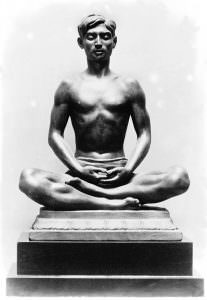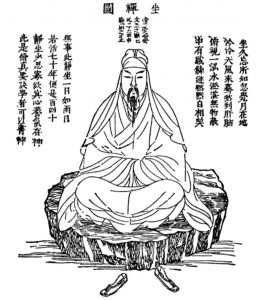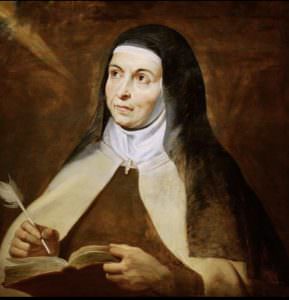Origin of Meditation
The origin of the practice of meditation is seen mainly in religious contexts throughout history. It can be traced back to prehistoric 5000 BC.
The earliest writings to be discovered were concerning meditation (Dhyana) originating from the Vedas of Hindu traditions around 1500 BCE.
Nearing 6 to 5 century BCE, was the period of the first development of other forms of meditation in Taoist China and Buddhist India.

Early Buddhism
The word Dhyana, as influenced by the Vedas in early Buddhism, means “contemplation and meditation” in all three religions of Hinduism, Buddhism, and Jainism, but the technical context is varied in each religion.
Meditation/Dhyana was incorporated into Yoga exercises, the goal being the extracting the various aspects of self-knowledge.
Over time meditation was developed further by the traditions of Hindu, Jain and Buddhist, influenced independently of the specific religions or by one influencing the other.
The most influential part of the traditions of the Hindu religion was that it involved self-directed awareness and is the part of the process where the yogi would find self, seek the self’s relationship with all living beings and where Ultimate Reality was to be found.
There is much debate concerning the origin of meditation on Buddhism but there are historical records dating to the 1st century BC, in the sutras of the Pāli Canon which set forth levels and states of meditation in Buddhism in India, and the formula for salvation:
(1) observance of the rules of morality
(2) contemplative concentration
(3) knowledge; and
(4) liberation.
This specifically places meditation as part of the path to salvation.

Soon, when Buddhism was spreading to and through China, the writings of the Vimalakirti Sutra (100CE) included meditations and enlightened wisdom which was practiced by the Zen.
(Zen is a combination of Indian Mahayana Buddhism and Taoism which started in China before spreading to Korea and Japan).
Harmonizing Greek and Jewish Philosophy
By 20 BCE a form of “exercises” of a spiritual nature had been written by Philo of Alexandria (who believed in the literal Hebrew Bible and who first attempted to harmonize Greek and Jewish philosophy). These spiritual exercises involved concentration and attention (prosoche).
By the 3rd century, a Greek philosopher named Plotinus developed meditation techniques based on his philosophy of “The One, The Intellect and The Soul.”
In Judaism in the Torah, Isaac is described as “lasuach” in the field. It has been interpreted by some that he was participating in some type of meditative practice.
In the King James Version of the Bible, in the Book of Genesis, “lasuach” is translated “meditation,” yet all commentaries define his action as prayer.
Throughout the Tanakh (the Hebrew Bible and a textual source of the Christian Old Testament) it is strongly suggested that Judaism always contained a tradition of meditation.
Japanese Buddhism
Beginning in the 8th century, the expansion of Japanese Buddhism meditation practices spread into Japan.
The first meditation hall was opened at Nara, Japan by monk Dosho after being introduced to Zen in China. The Japanese modified Chinese practices.
In Japan, around 1227, the first sitting meditation instructions (Zazen) were written by Dogen and the first community of monks was established.
Early Jewish meditation practices grew and developed and included meditative approaches to prayer.
Different forms of meditation were practiced, including Kabbalistic practices. Some involved approaches of Jewish philosophy.
Dhikr
The concept of Dhikr, or Remembrance of God in Islam, is interpreted by various meditative techniques and became one of the essential elements of Sufism, or Islamic mysticism, in the 11th and 12th centuries.
In Sufism, thinking leads to knowledge, and its followers practiced control of breathing as well as incorporated the repetition of holy words.
Christian Meditation
Eastern Christian meditation also involved the repetition of a phrase while in a specific posture and is traced back to the Byzantine  period.
period.
Hesychasm was developed on Mount Athos, Greece, and involves the repetition of the Jesus Prayer. This form of meditation is still being practiced today.
Western Christian meditation progressed from the 6th century Bible reading among the Benedictine monks (Lectio Divina or “divine reading”) but did not involve the repetition of phrases, actions or specific body posture.
In the 12th century, monk Guigo II termed four formal steps in Latin: lectio, meditatio, oratio, and contemplatio, which interprets “read, ponder, pray, contemplate.”
In the 16th Century of Western Christian meditation, saints such as Ignatius of Loyola and Teresa of Avila were instrumental in its development.
By the 18th century, the study of Buddhism in the West was a topic mainly focused upon by intellectuals.
French philosopher Voltaire sought toleration towards the Buddhists.
The first English translation of the Tibetan Book of the Dead was published in 1927.
Yoga
Schools of yoga began forming in Hindu revivalism in the 1890’s.
Gurus began introducing yoga schools to the West. Some yoga schools were designed particularly as secularized variations of yoga traditions to be used by non-Hindus.
One example is the Transcendental Meditation system which began its popularity in the 1960s.
In addition, various forms of Hatha Yoga were developed from the Ashtanga Vinyasa Yoga school, and eventually became simply known as “Yoga” in the West.
Secular Meditation
Secular meditation emphasizes stress reduction, relaxation, and self-improvement more than the spiritual aspects, although both secular and spiritual forms of meditation have been heavily analyzed by scientific research.
Scientific studies increase as more studies confirm the benefits of meditation over the past 60 years.
With such diversified history concerning the subject and despite 4500 years of practice and study, the mechanism of meditation that provides health benefits remains unclear.
Research continues with current Clinical studies underway and additional studies scheduled to take place.
REFERENCES
– A clinical guide to the treatment of human stress response by George S. Everly, Jeffrey M. Lating 2002 ISBN 0-306-46620-1 .
– Joseph, M. 1998, The effect of strong religious beliefs on coping with stress Stress Medicine. Vol 14(4), Oct 1998
– The origin of Buddhist meditation by Alexander Wynne 2007 ISBN 0-415-42387-2
– Zen Buddhism: a History: India and China by Heinrich Dumoulin, James W. Heisig, Paul F. Knitter 2005 ISBN 0-941532-89-5
– Hadot, Pierre; Arnold I. Davidson (1995) Philosophy as a way of life ISBN 0-631-18033-8
– Hans Urs von Balthasar, Christian meditation Ignatius Press ISBN 0-89870-235-6
– The Sutra of perfect enlightenment: Korean Buddhism’s guide to meditation by A. Charles Muller, 1999 ISBN 0-7914-4101-6
– Kaplan, Aryeh (1985). Jewish Meditation. New York: Schocken Books. ISBN 0-8052-1037-7.
– Zen Buddhism: a History: Japan by Heinrich Dumoulin, James W. Heisig, Paul F. Knitter 2005 ISBN 0-941532-90-9
– Soto Zen in Medieval Japan by William Bodiford 2008 ISBN 0-8248-3303-1
– The Cambridge History of Japan: Medieval Japan by Kōzō Yamamura, John Whitney Hall 1990 ISBN 0-521-22354-7,
– Alan Brill, Dwelling with Kabbalah: Meditation, Ritual, and Study in Jewish Spirituality and Divine Law by Adam Mintz, Lawrence H. Schiffman 2005 ISBN 0-88125-865-2
– Prayer: a history by Philip Zaleski, Carol Zaleski 2005 ISBN 0-618-15288-1
– Global Encyclopaedia of Education by Rama Sankar Yadav & B.N. Mandal 2007 ISBN 978-81-8220-227-6
– Sainthood and revelatory discourse by David Emmanuel Singh 2003 ISBN 81-7214-728-7
– Spiritual Psychology by Akbar Husain 2006 ISBN 81-8220-095-4
– “Mount Athos: History”. Macedonian Heritage. Archived from the original
– An introduction to the Christian Orthodox churches by John Binns 2002 ISBN 0-521-66738-0
– “Hesychasm”. OrthodoxWiki.
– Christian Spirituality: A Historical Sketch by George Lane 2005 ISBN 0-8294-2081-9
– Christian spirituality: themes from the tradition by Lawrence S. Cunningham, Keith J. Egan 1996 ISBN 0-8091-3660-0
– The Oblate Life by Gervase Holdaway, 2008 ISBN 0-8146-3176-2
– After Augustine: the meditative reader and the text by Brian Stock 2001 ISBN 0-8122-3602
– Enlightenment and reform in 18th-century Europe by Derek Edward Dawson Beales 2005 ISBN 1-86064-949-1
– Shakya, Tsering “Review of Prisoners of Shangri-la by Donald Lopez”. online
– Encyclopedia of Psychology and Religion by David A. Leeming, Kathryn Madden, Stanton Marlan 2009
If you like this post: This is how I learned to do it.


I really do not know much about meditation techniques, and now I just realised how deep the history goes when it comes to meditation practices. This really gives me a unique insight into the subject.
I am pretty sure that the different cultures being mentioned here, all have their own unique meditation principles. So what is the most popular one that is used in most modern meditation practices?
Great article!
Thank you for your comment. Meditation itself wasn’t even termed untiil the yoga period. In my blog on https://meditationforhealthyli… it explains:
Buddhist Influence – Mindfulness is achieved through focused attention on the body, breathing and control of thought.
Hindu Influence – The goal is to reach a state of nothingness, resulting in a loss of sense of self and duality (the mind and body acting as one). Modern practices depend on what part of the world you refer to. When meditation was introduced to the western world, transcendental meditation is what developed from Yoga (see section on Yoga). The modern meditation techniques most utilized today include relaxation techniques, and Yoga with its variations. It is described that the best technique is the one that works for you. I found that to be true when I began researching it for myself. What works for me is actually a combination of two or three techniques.
Hi Carole,
To be such a novice on something I hold so close to my heart, re the practice of meditations. I simply have very little knowledge of its origins other than mystic or guru photos.
Meditation is a gift I try to give myself every day. Having read this article I feel a deeper understanding of why it is so beneficial because of its origins and the people who first performed it, to whom I have the greatest respect.
Ommm mate
May you always be aware of the peace that surrounds you and that lives inside you.
Paul
Thank you, Paul. The goal of this website is to provide this type of information. As part of my research I asked a number of people who actually participate meditation several questions. I was surprised that a greater percentage really didn’t know the answer to most of the questions. This is how I developed my topics. The purpose of creating this website is to provide information to expand your knowledge and understanding. You are one of the first who will go into your next session with a more in-depth perception of what you are doing and why.
May this bring you additional peace!
Carole.
Hi Carole,
What a lovely site and I have to say that I did taste the beauty of meditation, as well as asanas, some time back…
I had stopped practicing it regularly, but once in a while, when everything seems to be going wrong, I meditate and do some postures, and things don’t seem so bad afterward. It really does work…
I found your site here to be extremely informative, and I enjoyed reading some of your work.
Thank you, James for taking the time to look around at what MHL is all about. Meditation does work. We must not forget that the reason we start to experience such levels of peace and contentment is a direct result of meditation. How we feel is a matter of perspective. I discuss in one of the other blogs how the benefits are such that meditating should be as much a part of our lives as going to bed every night.
You are welcome. I have many more topics to cover in the future.